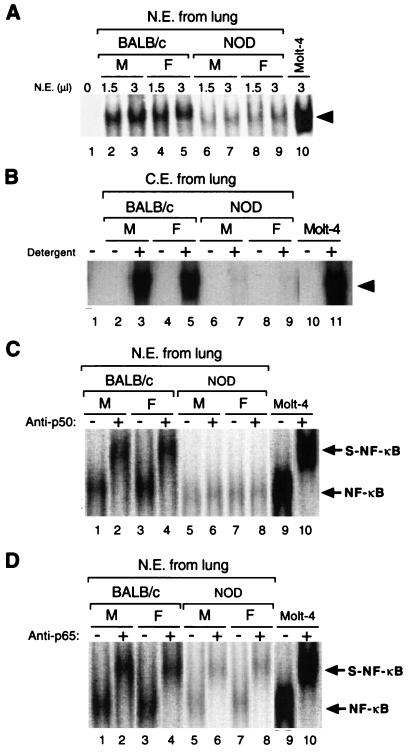FIG. 1.
Comparison of the DNA-binding activities of NF-κB in lymphocyte-enriched lung cells of NOD mice and control BALB/c Mice. (A) NF-κB DNA-binding activity in the indicated amounts of nuclear extract (N.E.) of lymphocyte-enriched lung cells from male (M) and female (F) NOD and BALB/c mice, as well as that in nuclear extract of TNF-α-treated Molt-4 cells, was analyzed by EMSA with a 32P-labeled oligonucleotide (κB1) containing the κB binding motif. Lane 1 corresponds to a negative control in which nuclear extract was not added to the reaction mixture. The arrowhead indicates the putative NF-κB–DNA complexes. (B) NF-κB DNA-binding activity in cytosolic extract (C.E.) prepared from lung lymphocytes of male and female NOD and BALB/c mice, as well as that in cytosolic extract of Molt-4 cells, was analyzed by EMSA with 32P-labeled κB1 oligonucleotide after incubation with (+) or without (−) NP-40 and deoxycholate detergents. Lane 1 corresponds to a negative control in which extract was not added. (C and D) Supershift analysis of the κB-binding proteins in lung cell nuclear extracts from NOD and BALB/C mice. Nuclear extracts were incubated in the absence (−) or presence (+) of polyclonal antibodies to p50 (C) or p65 (D) before EMSA analysis with the κB1 oligonucleotide. Original DNA-protein complexes (NF-κB) and supershifted DNA-protein complexes (S-NF-κB) are indicated by arrows. Lanes 9 and 10 correspond to control incubations performed with nuclear extract of TNF-α-treated Molt-4 cells.

